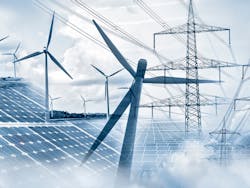The New York Independent System Operator’s (NYISO) top priority is preparing for sweeping changes to the state’s grid, including a sharp increase in distributed energy resources (DERs) and energy storage, according to the grid operator.
“New York State policies set forth the most aggressive clean energy mandates in America,” NYISO CEO Richard Dewey said in the annual Power Trends 2020 report, released this week. “There is no precedent for the level of change needed to meet these objectives.”
New York aims to cut its greenhouse gas emissions by 40% below 1990 levels by 2030 and by 85% by 2050. State law also calls for 70% of New York’s electricity to come from renewable energy facilities by 2030 and to be emissions-free a decade later.
COVID-19 reduces short-term demand outlook for NYISO
The report comes amid the new coronavirus pandemic, which has reduced New York’s overall electric use while also causing a shift in daily demand patterns.
In response, NYISO lowered its annual overall energy consumption forecast for this year by about 7%. Electric use will also be below original forecasts for next year, according to the grid operator.
However, in the long-term, NYISO expects electric use to increase, partly reflecting plans to electrify the transportation and building sectors. Electric vehicles, for example, will increase wintertime peak load by close to 3,000 MW and use nearly 16,000 GWh by 2040, according to NYISO’s forecast.
Under a baseline scenario, NYISO expects overall electric use to grow to about 184,000 GWh by 2040, up from about 156,000 GWh last year.
Meanwhile, in the last year NYISO set new rules for market participation from DERs and energy storage resources, and developed new planning rules to reflect how new technologies can interconnect to the grid, the grid operator said.
Further enhancements are either under regulatory consideration or part of discussions with stakeholders to further enhance market design, according to NYISO.
New rules for DERs, energy storage
NYISO is implementing rules this year that allow energy storage to take part in NYISO’s wholesale markets and is exploring market participation options for resources that combine storage with renewable generation.
“Developing a method for hybrid resource participation in the wholesale markets will support policy efforts to integrate more clean energy into the grid,” NYISO said.
Looking ahead, NYISO expects energy storage capacity on its system to grow to about 2,000 MW by 2027, 3,000 MW by 2031, 4,000 MW by 2034 and 5,000 MW by 2039.
NYISO has also developed rules integrating DERs into wholesale markets through the use of aggregations. The Federal Energy Regulatory Commission approved the rules in January and they are set to take effect next year.
“DERs offer the potential to make load more dynamic and responsive to wholesale market price signals, potentially improving overall system efficiencies,” NYISO said.
NYISO also started allowing “dual participation” of DERs to serve bulk-system and local distribution systems.
“As a next step, the NYISO will develop market concepts to encourage the participation of flexible load, which will become increasingly important as deployments of intermittent wind and solar resources rise to support New York’s decarbonization goals,” the grid operator said.
Carbon pricing under review
In a move that could affect DERs and other renewable resources, NYISO is moving forward with possible adoption of carbon pricing.
“NYISO and many of its stakeholders believe that instituting carbon pricing would help the state meet its clean energy objectives faster and more cost-effectively while preserving appropriate market-based price signals for maintaining grid reliability,” the grid operator said.
Any carbon pricing plan would need to be approved by stakeholders, NYISO’s board and FERC.
Track news about DERs and energy storage. Subscribe to the free Microgrid Knowledge newsletter.







